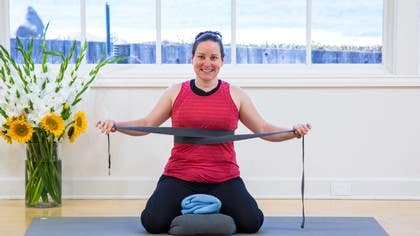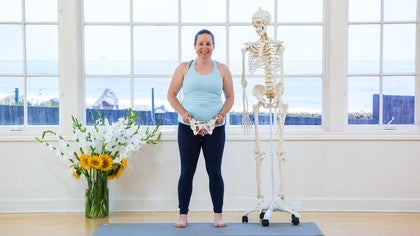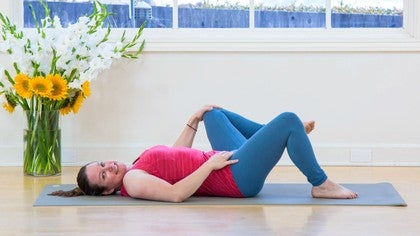Description
About This Video
Transcript
Read Full Transcript
Welcome, I'm so excited to share Breath for Pelvic Health with you today. Breath is one of the main components for pelvic health and so we're going to go through ribcage breath, jellyfish breath and basement breath together as well as some movement. So let's first start with ribcage breath. We'll bring hands to the ribcage if you can and imagine that the ribcage is an umbrella and that it has this lateral movement, so it's moving out to the side and all around on the inhale and on the exhale it's going back towards itself. So we'll bring the hands to feel that movement in the ribcage.
And what's amazing is that just that breath alone is what offers some movement to the diaphragm and the pelvic floor. So if you imagine that the pelvic floor and diaphragm are on the inhale moving down and on the exhale they're moving up and it's just happening so all we need to focus on is ribcage breath at that point. And some things to watch for. So watch if you put one hand on the sternum right over the heart and watch for if there's a lifting. So you might experience like a little lift in the ribcage and we want to avoid that and instead focus on the ribcage moving.
And the other thing to just be mindful of is where that breath is touching to the belly. So what will happen is the ribcage expands, the diaphragm and pelvic floor move down and then we might feel the belly extending a little bit but it's not like more breath is better. So we want to see if we can take it a normal inhale that's not expanding, expanding, expanding or going all to belly breath. And just notice how that feels. That's great.
And then we're going to move down to the floor so that we can feel the floor onto the ribcage as well. Still lowering all the way down, coming down to lie down on the back. So holding onto the ribcage here and it might be more about holding the front of the ribcage. You can let the middle fingers touch at the center line of the body and often we focus on the front of the body when we think about an inhale but see if you can breathe into the back body and the sides with each inhale. And exhale and soften the ribcage.
So you might notice that the fingers move away from each other a little bit on that inhale and the exhale they come towards each other. And again remember that more is not better with breath so we start to again notice if the breath is going into the belly for this one. Not that it's bad when the breath goes into the belly but for this one we really want to focus on the ribcage breath. So we can see when I inhale is it all about the belly or does it just touch into the belly at the end of the inhale? You may want to place a sandbag or maybe a bag of rice or a bag of potatoes onto the abdomen if you feel like it's really about the belly breathing for you so then you can make it about the ribcage breath and a real soften on the exhale where you feel the abdomen go back towards the floor.
And then we'll slide the sandbag off if we have a sandbag and we'll come to roll over onto the belly. Putting the head down onto the hands and noticing the ribcage breath here does this change it? And if you have a sandbag then you can place it along the back and it's not easy to do by yourself at home maybe so you might want to ask a friend to help you with it. And you can really feel the expansion of the ribcage at the back still. And then we'll slowly move the sandbag off to the side.
Come all the way up to sitting and now bringing if you have a bolster or a pillow at home or a blanket rolled up and what I've created here is like a bolster with a blanket folded on top because we want to be sitting right on this and most important is to find comfort. So we're going to sit so that we're sitting right onto the blanket and the bolster. So once you're seated here then we're going to explore the ribcage breath a little bit more and see how it feels now and also what I found really helpful is to bring a strap or a belt or a towel in and bring it around back behind you, you're going to cross it over at the front and bring it up so that it's along the ribcage at the back. So once you have that strap crossed over and we're just holding gently we're not pulling really hard or anything then we'll inhale and feel that expansion all the way around the ribcage and exhale. So I think what's great about this is you will likely notice the strap slides and moves a little bit but it's really subtle.
We unwind that here so each inhale and each exhale is doing so much for our public health and sometimes it's not that we don't know how to breathe but maybe the body has gotten into a pattern where it's not breathing in its natural state what we're born with. So one great example of this is when we are sitting and watching Netflix then we're kind of slouching back so we have this movement of pelvic floor and diaphragm have to kind of move together. So sitting up on a bolster like this or maybe blocks or a pillow or a blanket really helps with that and also the next thing that we can feel is that the perineum right between the anus and the vagina is making a connection here so we can notice the pelvic floor. So one really vital important thing about the pelvic floor is that it has this movement down as well as up. Sometimes we're a little more focused on thinking holding pelvic floor but for this breath it's called the basement breath.
So each inhale we feel pelvic floor soften down towards whatever we're sitting on and if you're worried that you can't really feel that know that it's happening anyway so as soon as we focus on that ribcage breath it's happening, pelvic floor lowers down. One great way to think of it and why it's called the basement breath is it's like we are in an elevator and we're at the ground floor and on the inhale we're going to imagine that the pelvic floor can move even further down. And on the exhale there's a slight lift often times we might get into really trying to clench and hold so instead I like to use the visualization of a jellyfish. So if a jellyfish is floating towards the bottom of the ocean that's on the inhale and then on the exhale there's just a very slight lift of that jellyfish so if you imagine how a jellyfish floats through the ocean it just lifts so gracefully so gentle. And you might want to close your eyes and it's okay if you're thinking oh my gosh I'm not feeling this am I doing it right go back to that ribcage breath and it will naturally happen.
Another great way to really feel basement breath here or that movement of pelvic floor is to come down to sideline and you can bring your blanket and your bolster with you if you want you might use it you may not. So we'll slide that out and come down to lying on your side I find it helpful to prop my head up with my hand but you could also lay down or use a pillow here as well. And so we're going to bend the knees and start to bend the top knee it might rest on your blanket your bolster here and we're going to feel for the sitz bone. So if you're not sure it's the very bottom if you feel that bone at the base of the pelvis and you might dig around a little bit and this is where it's fun that you guys are at home and I'm the one who's showing this to everyone but you're going to feel for that sitz bone and then wrap the fingers around and feel just inside that sitz bone. So then you're holding on to pelvic floor and I feel like this is the one way to really have that awareness so if we hold here and we take an inhale we might feel the movement of pelvic floor and if you're thinking I'm not feeling it just take a few breaths here.
So you might even feel it moving. So it's going to move down pelvic floor is moving down on the inhale and it's moving back up on the exhale. And if you're thinking gosh I'm not finding it here go back to rib cage breath. Know that it's happening. And play around a little bit so some people feel this movement more when they have knees together or the knee lifted a little bit more or if you wrap the hand a little bit more towards pelvic floor around that sitz bone.
And the really cool thing is that it's different from side to side. So we're going to roll over and find the other side. So again you can use the bolster the blanket. Take a little time to roll over to the other side. And then find that sitz bone and you can feel that sitz bone when you're moving the knee.
So if you're wondering where that is find the sitz bone and then just wrap the fingers inside that sitz bone to feel pelvic floor. So the inhale you might feel pelvic floor moves down towards the fingers. See if you can soften, imagine that jellyfish or the basement going down in the elevator. And on the exhale it lifts up a little bit. Great.
We're going to come up and come down to lying on the back so that we can work with how the pelvic floor is naturally moving. So remembering pelvic floor and diaphragm are both moving down on the inhale and then they're moving back up on the exhale. Placing your hands wherever they're comfortable. So they might be at the sides to start. You might want to place them in a little T shape or up overhead.
You're planted firmly on the floor, spread the toes out a little bit. And on the next inhale we're going to try and lift on the inhale first and lower on the exhale. I feel like a lot of the time we'll find that in yoga. At least I did at first in my yoga practice but we're going to switch it around. Not that that inhale lift is something wrong but let's try and move with pelvic floor.
So if we imagine pelvic floor and diaphragm are moving down on the inhale. So we take our inhale here. And then on the exhale when we lift they're naturally moving back. So inhale lower and exhale lift. And you may be able to feel that slight movement.
You can lift as high as you would like in your bridge. Remembering that more is not better. And then if you wanted to add the arms in you can. I like to just to make the brain do some work. So if we bring the hands down by the sides, our exhale we lift the pelvis, the arms stay down by the sides.
And then on the inhale arms can lift up and pelvis lowers. And then as you exhale lifting pelvis, lowering the arms down to the sides. Let the breath really guide you here. Inhale arms come up, pelvis lowers down. Exhale lifting pelvis, lowering arms down.
Inhale bringing arms up, lowering pelvis down. And then pause here for a moment. Just come back to that ribcage breath, set the arms where they're comfortable. See if there's any last movement that you'd like. Maybe it's a little sway side to side with the knees.
Before we settle into our relaxation, you might want to bolster behind the knees. You might want to change where the arms are. Either down by the sides a little bit more, start to straighten the legs. We're going to notice the breath and even soften the breath. Let it happen naturally, not like we're trying to force the breath.
The eyes might soften or close. And where are you feeling that breath now? Is it in the ribcage? Is it higher up? Are you noticing where the breath moves into the belly?
Is there any part of your body that you could kind of stretch out, wiggle out to find more of a connection to the earth? So this breath is happening all the time. It's something that we don't have to be conscious of all the time, but if we just take some time together to find this ribcage breath, jellyfish breath, basement breath, we can offer a little reset to the body. And for those of you who want to stay here longer, you're welcome to do so. You're going to start to make small movements with fingers and toes, pointing and flexing, maybe making circles, possibly deepening the breath a little bit.
Come back to that ribcage breath, maybe lengthening the arms, lengthening through the feet. Being ready to roll over to one side and pausing here on your side, using your arms to bring you up to sitting. Thank you for practicing some breath with me today. If you have any questions, feel free to put those in the comments and let me know how this practice was for you. Namaste.
Yoga for Women's Health: Yoga For Pelvic Health
Comments
As a side note - during pregnancy breath practices that are contraindicated are ones that are really heated or vigorous or that involve breath retention.
You need to be a subscriber to post a comment.
Please Log In or Create an Account to start your free trial.














